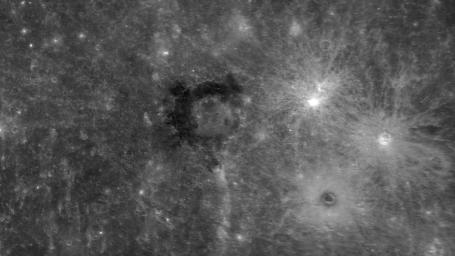
|
Dark Doings at Derain
- Click the image above for a larger view
- Full-Res JPEG (1920 x 1080) (220.9 kB)
- Full-Res TIFF (1920 x 1080) (2.1 MB)
Caption:
In the center of this image is Derain , an impact crater first viewed during MESSENGER's second Mercury flyby and named in 2009 . Derain has material within and surrounding the crater that is much darker than the neighboring terrain. In fact, the material associated with Derain appears to have the lowest reflectance yet identified on Mercury's surface. The dark deposits may be material with a mineralogical composition different from the majority of Mercury's visible surface, but more data are needed before any further insight into the composition can be gained. Observations to be acquired during MESSENGER's orbital mission phase will help to identify the uncommonly dark material at Derain and similar occurrences elsewhere on the planet.
Also visible in this image, to the southeast of Derain, is the rayed crater Berkel , which has dark material in its center and in a ring immediately surrounding it. In contrast, two neighboring craters to the north of Berkel have bright rays but lack dark halos. Why do some craters contain dark materials while others do not? MESSENGER's orbital data will be used to investigate that question and to improve our understanding of the nature and structure of Mercury's crust.
Date Acquired:
October 6, 2008
Instrument:
Narrow Angle Camera (NAC) of the Mercury Dual Imaging System (MDIS)
Scale:
Derain is 190 km in diameter (118 miles)
Background Info:
These images are from MESSENGER, a NASA Discovery mission to conduct the first orbital study of the innermost planet, Mercury. For information regarding the use of images, see the MESSENGER image use policy .
Cataloging Keywords:
| Name | Value | Additional Values |
|---|---|---|
| Target | Mercury | |
| System | ||
| Target Type | Planet | |
| Mission | MESSENGER | |
| Instrument Host | MESSENGER | |
| Host Type | Orbiter | |
| Instrument | Mercury Dual Imaging System (MDIS) | |
| Detector | Narrow Angle Camera (NAC) | |
| Extra Keywords | Crater, Grayscale, Impact | |
| Acquisition Date | ||
| Release Date | 2010-10-12 | |
| Date in Caption | 2008-10-06 | |
| Image Credit | NASA/Johns Hopkins University Applied Physics Laboratory/Carnegie Institution of Washington | |
| Source | photojournal.jpl.nasa.gov/catalog/PIA13488 | |
| Identifier | PIA13488 | |
